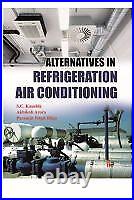

Handbook of Air Conditioning and Refrigeration. Provides essential, up-to-date HVAC data, codes, standards, and guidelines. A handbook that provides practical and updated material on air conditioning and refrigeration systems, produced by an author with over 50 years experience as a practicing engineer under his beltWhether you’re an HVAC or mechanical engineer, technician, or student, providing an effective controlled environment through air conditioning and refrigeration technology is now within reach. This guide provides you with all the answers on AC and refrigeration systems-from designing and selection to operation and maintenance. Here you get it all – the latest in technological advances in air conditioning and refrigeration-in one unique volume. Air Conditioning and Refrigeration produces an effectively controlled indoor environment with an acceptable indoor air quality for health, comfort, and manufacturing processing. The goal of the Handbook Air conditioning and Refrigeration 2/e is to provide useful, practical and updated technical reference for the design, selections, and operation of air conditioning and refrigeration system. Because of the trend to use computer programs to calculate space loads, to estimate annual energy, and to perform duct and piping work design, the Handbook of Air and Refrigeration has become dated. In the first edition the Handbook provided data and charts for and calculations. Now most of this work is done on computer. Therefore the author is proposing to change the handbook so that it is directed at the computer user. He, also, intends to cover all the technological changes since the last edition in this rapidly changing field. A handbook that provides practical and updated material on air conditioning and refrigeration systems, produced by an author with over 50 years experience as a practicing engineer under his belt. Whether you’re an HVAC or mechanical engineer, technician, or student, providing an effective controlled environment through air conditioning and refrigeration technology is now within reach. This guide provides you with all the answers on AC and refrigeration systems–from designing and selection to operation and maintenance. This book provides: Design information HVAC data, standards, and guidelines A system-wide approach Use of computers and controllers in AC and refrigeration systems Chapters ranging from management and control systems to system selection, commissioning, and maintenance. So don’t waste valuable time searching through numerous resources. Here you get it all — the latest in technological advances in air conditioning and refrigeration–in one unique volume. Wang (Alhambra, CA) holds master degrees from Harvard and MIT. He is the former Deputy Director, Chief Engineer for the Institute of Air Conditioning in Beijing, China, and has 50 years experience as a practicing engineer. He is the author of 11 books in the HVAC area. Preface to Second Edition. Preface to First Edition. Chapter 3: Heat and Moisture Transfer through Building Envelope. Chapter 4: Indoor and Outdoor Design Conditions. Chapter 5: Energy Management and Control Systems. Chapter 6: Load Calculations. Chapter 7: Water Systems. Chapter 8: Heating Systems, Furnaces, and Boilers. Chapter 9: Refrigerants, Refrigeration Cycles, and Refrigeration. Chapter 10: Refrigerants Systems: Components. Chapter 11: Refrigeration Systems: Reciprocating, Rotary, Scroll, and Screw. Chapter 12: Heat Pumps, Heat Recovery, Gas Cooling, and Cogeneration Systems. Chapter 13: Refrigeration Systems: Centrifugal. Chapter 14: Refrigeration Systems: Absorption. Chapter 15: Air Systems: Components – Fans, Coils, Filters, and Humidifiers. Chapter 17: Air Systems: Air Duct Design. Chapter 18: Air Systems: Space Air Diffusion. Chapter 19: Sound Control. Chapter 20: Air Systems: Basics and Constant-Volume Systems. Chapter 21: Air Systems: Variable-Air-Volume Systems. Chapter 22: Air Systems: VAV Systems – Fan Combination, System Pressure, and Smoke Control. Chapter 23: Air Systems: Minimum Ventilation and VAV System Controls. Chapter 24: Improving Indoor Air Quality. Chapter 25: Energy Management and Global Warming. Chapter 26: Air Conditioning Systems: System Classification, Selection, and Individual Systems. Chapter 27: Air Conditioning Systems: Evaporate Cooling Systems and Evaporative Coolers. Chapter 28: Air Conditioning Systems: Space Conditioning Systems. Chapter 29: Air Conditioning Systems: Packaged Systems and Desiccant-Based Systems. Chapter 30: Air Conditioning Systems: Central Systems and Clean-Room Systems. Chapter 31: Air Conditioning Systems: Thermal Storage Systems. Chapter 32: Commissioning and Maintenance. Appendix A: Nomenclature and Abbreviations. Appendix B: Pyschrometric Chart, Tables, and I-P Units to SI Units Conversion. Country of Publication United States. Short Title HANDBK OF AIR CONDITIONING & R. UK Release Date 2000-11-16. AU Release Date 2000-11-16. NZ Release Date 2000-11-16. US Release Date 2000-11-16. Publisher McGraw-Hill Education – Europe. Edition Description 2nd edition. Illustrations 482 Illustrations, unspecified. Audience Tertiary & Higher Education. We’ve got this. At The Nile, if you’re looking for it, we’ve got it.









